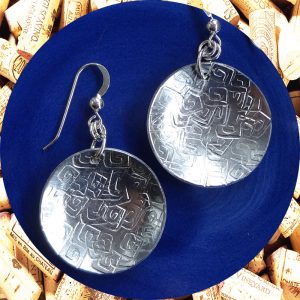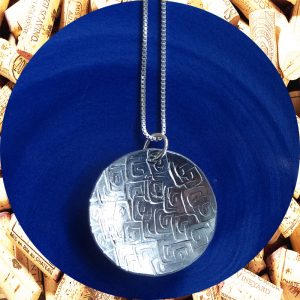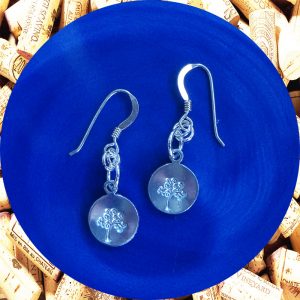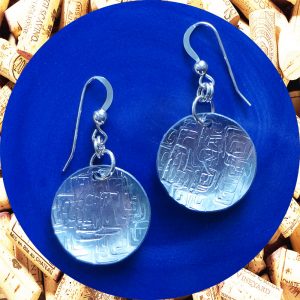Small Round Starfish Print Aluminum Pendant Necklace
$27.00
Handcrafted Small Round Starfish Print Aluminum Pendant Necklace. The concave round-shaped aluminum form is embellished with a sensational starfish print embedded in the aluminum disk which is suspended on a light oval cable Italian Sterling Silver chain. The chain is available in 16 inches or 18 inches at no extra cost, just choose which you would like
Description
- Small Round Starfish Print Aluminum Pendant Necklace is 9.5 mm in diameter and is composed of Premium Aluminum.
- A sensational starfish print adorns these handcrafted gems.
- The sensational symbolic starfish means a great many things to many people around the world:
- Christians believe starfish represents Stella Maris (Star of the Sea) who lovingly creates safe travel over troubled waters, yet they also believe in the celestial version which speaks to infinite divine love, as an emblem of salvation during trying times, such as guidance, vigilance, inspiration, brilliance, and intuition.
- Egyptians believe the starfish is connected to the mother goddess Isis, who had a Salvation Army motto: “Befriending the friendless” = the mother and friend to slaves; the impoverished and those in dire need; the guardian to troubled seafarers on the Red Sea and abroad.
- Romans believed that the starfish was the love goddess Venus, the sensory goddess of feeling and emotion who also governs tactile, physical attributes (two arms, two legs and the top limb as the head) Venus and the starfish make a symbolic duo of love, sensitivity, emotion, and physical wholeness.
- Tsimshian Haida-Eagle has a sub-clan called the starfish clan making the starfish as an emblem because they observed it to be super-strong. Its ability to crack into a mussel shell proved great strength and longevity due to the starfish’s ability to regenerate, therefore, to be immortal.
- Extremely lightweight, durable, and with the added benefit of a non-tarnish surface.
- Each Pendant is suspended on a light oval cable Italian Sterling Silver chain.
- The chain is available in 16 inches or 18 inches at no extra cost, just choose which you would like
- These beauties should give you years and years of sensational wear.
Discovery of Aluminum by Dr. Doug Stewart
People have used alum since ancient times for dyeing, tanning and to stop bleeding. Alum is potassium aluminum sulfate.
In the 1750s German chemist Andreas Marggraf found he could use an alkali solution to precipitate a new substance from alum. Marggraf had previously been the first person to isolate zinc in 1746.
The substance Marggraf obtained from alum was named alumina by French chemist Louis de Morveau in 1760. We now know that alumina is aluminum oxide – chemical formula Al2O3.
De Morveau believed alumina contained a new metallic element, but, like Marggraf, he was unable to extract this metal from its oxide.
In 1807 or 1808, English chemist Humphry Davy decomposed alumina in an electric arc to obtain a metal. The metal was not pure aluminum, but an alloy of aluminum and iron.
Davy called the new metal alumium, then renamed it aluminum.
Aluminum was first isolated in 1825 by Hans Christian Ørsted (Oersted) in Copenhagen, Denmark who reported, “a lump of metal which in color and luster somewhat resembles tin.”
Ørsted produced aluminum by reducing aluminum chloride using a potassium-mercury amalgam. The mercury was removed by heating to leave aluminum.
German chemist Friedrich Wöhler (Woehler) repeated Ørsted’s experiment but found it yielded only potassium metal. Wöhler developed the method further two years later, reacting volatalized aluminum trichloride with potassium to produce small amounts of aluminum. (1)
In 1856 Berzelius stated that it was Wöhler who had succeeded in 1827. Wöhler is therefore usually given credit for the discovery.
More recently, Fogh repeated the original experiments and has shown that Ørsted’s method can give satisfactory results.
This has strengthened the priority of Ørsted’s original work and his position as discoverer of aluminum.
For almost three decades, aluminum remained a novelty, expensive to produce and more valuable than gold, until in 1854 Henri Saint-Claire Deville in Paris, France found a way of replacing potassium with much cheaper sodium in the reaction to isolate aluminum. Aluminum then became more popular but, because it was still quite expensive, was used in ornamental rather than practical situations.
Finally, in 1886 American chemist Charles Martin Hall and French chemist Paul Héroult independently invented the Hall-Héroult process, which inexpensively isolates aluminum metal from its oxide electrolytically.
Aluminum is still manufactured using the Hall-Héroult process today.
Classification: Aluminum is an ‘other metal’
Color: silvery
Atomic weight: 26.98154 g/mol
State: solid
Melting point: 660.32 oC, 933.57 K
Boiling point: 2466.85 oC, 2740.00 K
Electrons: 13
Protons: 13
Neutrons in most abundant isotope: 14
Electron shells: 2,8,3
Electron configuration: 1s2 2s2 2p6 3s2 3p1
Density @ 20oC: 2.702 g/cm3
Starfish Print Aluminum Pendant Necklace
Additional information
| Chain Length | 16", 18" |
|---|





